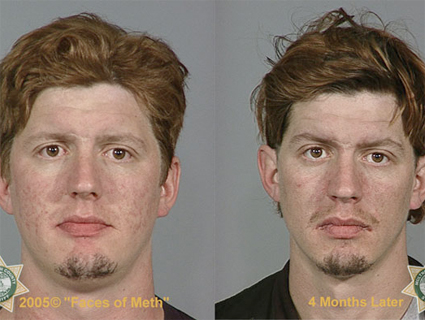
Box: <a href="http://www.flickr.com/photos/laurafries/61632567/sizes/m/in/photolist-6rTdt-8K7GFS-tq3vU-4oggzn-xDWaB-5rZU3R-yandg-DubsE-2mzvGx-8xjGx-6iwFdw-JPiT8-5WgcGe-7GbCdz-D3b81-4K6Z6n-azfrLa-7vxv1t-DP9pu-5NcMhv-wD95T-aua2xz-aNvkpD-5G7NbT-5pDo4V-4hRsUG-5VvdRi-qLMT8-5VHPsB-4rk8oN-723DAg-7oCGE8-DLFhQ-bWSx3Z-87Tyv-dSR7GH-aA9wyZ-asYD1p-2SSbm8-818BPD-8LYXcA-8Fyn35-8TWCnm-ggUrS-yxgyP-5NRkrK-9MGDaR-bXrNW9-5k2PhB-5LHBCZ-921met/">LauraFries.com</a>/Flickr; Pills: <a href="http://commons.wikimedia.org/wiki/File:Sudafed_Pills.jpg">ParentingPatch</a>/Wikimedia Commons; Chef: Shutterstock
|
YEAR |
LEGISLATIVE ACTION |
REACTION |
|
1980 |
The federal government tightens restrictions on phenyl-2-propanone, used to make methamphetamine. |
Meth producers switch to ephedrine and pseudoephedrine, used in cold meds, to produce a more potent form of meth. |
|
1986 |
Fresh from its, and so far only, victory against a drug—control of the chemical used to make quaaludes—the Drug Enforcement Administration proposes controls for ephedrine and pseudoephedrine. |
Pharma lobbyist Allan Rexinger calls the White House, which “basically intervened on our behalf,” Rexinger tells the Oregonian in 2004. “After that we had useful negotiations with the dea.” |
|
1988 |
The Federal Chemical Diversion and Trafficking Act mandates recordkeeping for various drug precursor chemicals. Industry wins an exemption for ephedrine and pseudoephedrine in pill form. |
Meth producers and their suppliers switch to ephedrine and pseudoephedrine in pill form. |
|
1993 |
The Domestic Chemical Diversion and Control Act closes the ephedrine pill loophole, but pseudoephedrine exemption remains. |
Labs switch from ephedrine to pseudoephedrine pills. |
|
1996 |
The Comprehensive Methamphetamine Control Act closes the pseudoephedrine pill loophole. Industry, with help from Sen. Orrin Hatch (R-Utah), wins exemption for pills sold in blister packs. |
Labs switch to blister packs. |
|
2000 |
The Methamphetamine Anti-Proliferation Act reduces the amount of pseudoephedrine that can be sold in a single transaction. Blister packs are again exempted. |
Meth labs proliferate nationwide. |
|
2004 |
Oklahoma becomes the state to put pseudoephedrine behind the counter. Industry fights the measure. |
Meth labs plummet in Oklahoma, encouraging other states to follow suit. |
|
2005 |
The Federal Combat Methamphetamine Epidemic Act requires stores to put pseudoephedrine behind the counter (without requiring a prescription) and limits how much an individual can buy. Industry says this will hurt consumers and won’t reduce labs. |
Meth lab incidents fall 61 percent nationwide. But cooks begin employing smurfers to go from pharmacy to pharmacy and buy the maximum amount allowed. |
|
2006 |
Oregon makes pseudoephedrine a prescription drug despite massive industry lobbying. |
Meth lab incidents decrease 96 percent in Oregon over the next six years. |
|
2007 |
Bucking industry opposition, Mexico bans most pseudoephedrine. |
Potency of meth being smuggled into the US plunges as Mexican labs switch to other chemicals. |
|
2009 to present |
Lawmakers in 24 states try to make pseudoephedrine a prescription drug. In DC, Oregon Sen. Ron Wyden drafts a federal prescription bill. |
All but one of the bills are defeated. Citing consumer concerns and “heavy industry spending,” Wyden never introduces his legislation. |













